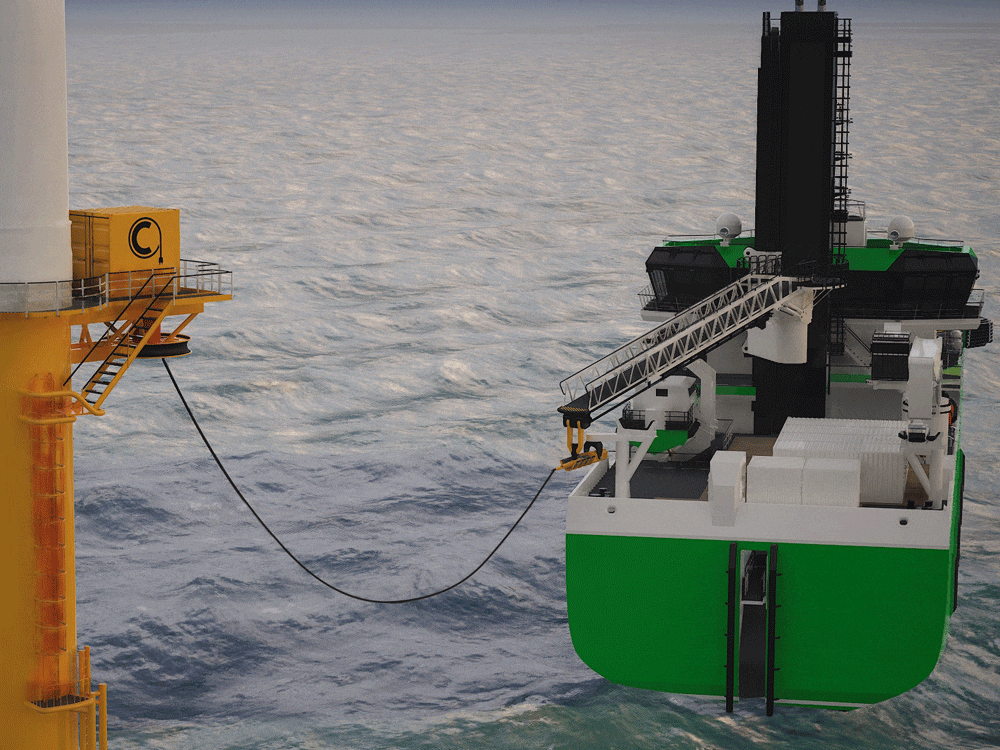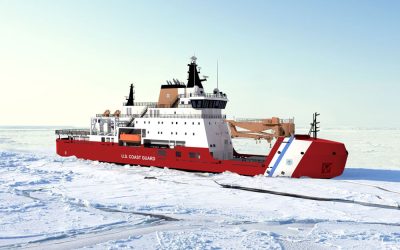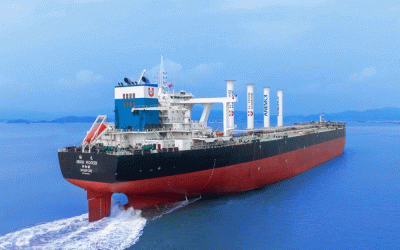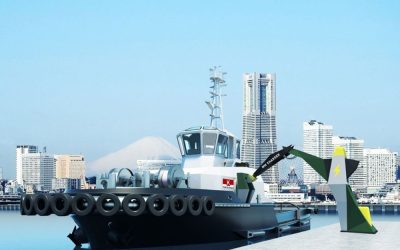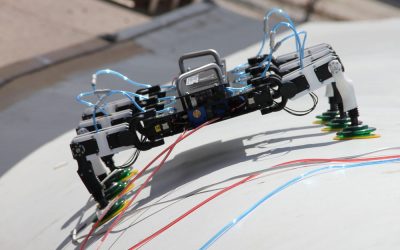The new 7017 E service operation vessel (SOV) from Damen has a trick up its sleeve – or more accurately, at the end of its gangway, writes Stevie Knight. Importantly, it’s a trick that promises to allow the vessel to run on battery power alone.
This recent 4,300gt design will, like its SOV 7017 predecessor, accommodate windfarm technicians and crew in 60 single cabins. Its 70m length, 17m beam and 4.5m service draught yield enough room for 90m3 of cargo on a weather deck area of about 300m2. The SOV also houses a 420m2 covered warehouse on the main deck, directly accessible via an adjustable platform and walkway from the steel boat landing at the stern.
The propulsion makes use of Damen’s DPX-DRIVE, which features four 900kW azimuthing thrusters in a double-ended arrangement. At summer draught, this yields 10knots in eco-mode, increasing to 12knots max, and grants the vessel independent propulsion in any direction.
Although Damen has scoped out a smaller 10MW battery for this ship, the main design has a capacious 15MW of energy storage, allowing fully electric running almost all (that is, 98%) of the time. As a result, the battery room of the 7017 E is somewhat larger than that of the original hybrid 7017. It is positioned in the last third of the vessel – just before the aft-end kit – though, as Damen project engineer Rebecca Belmer explains, “it hasn’t made so much difference to the layout”, as this newer vessel takes advantage of both the space left by the original methanol system and that reserved for battery upgrades.
Central to the ‘stepless access’ for the technicians, tools and parts is a fully motion-compensated crane and tower-mounted, 25m gangway. The gangway comes with an integrated elevator, adjustable to yield working heights 14-25m above sea level. Further, it can be intertwined with wave radar and motion prediction systems that anticipate vessel movement over one minute in advance, yielding smoother, safer transfers.
Given that the gangway is already a sophisticated piece of kit, it’s a clever move to utilise the existing technology to deliver an onsite charge. This was accomplished with the help of MJR Power & Automation, and follows earlier demonstrations aboard Tidal Transit’s 20m CTV TIA Elizabeth, which MJR used to demonstrate how the single-point mooring and umbilical system would work in practice.
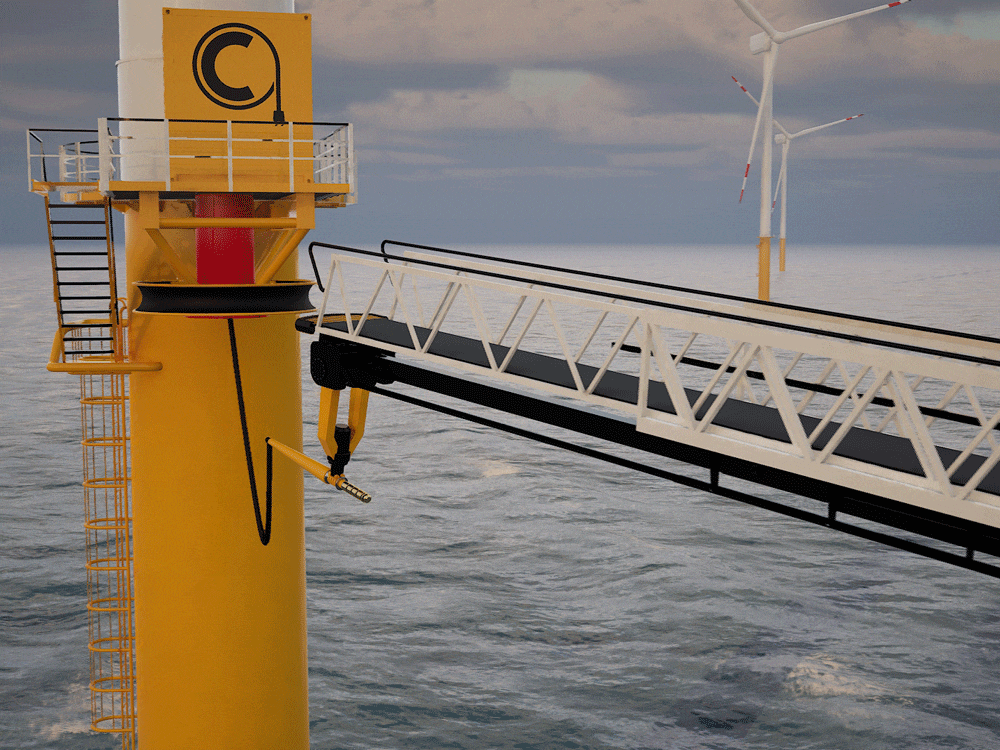
The charging operation is entirely controlled from the wheelhouse, with no manual interaction
After slot booking and confirmation, the vessel approaches the tower, where a fully automated reel drops a connector into a receptacle on the vessel. For the SOV, it has been developed into a slightly slicker system with the connection point on the shipboard side suspended just below the very tip of the extended gangway. As the operation is entirely controlled from the wheelhouse, there is no manual interaction. MJR managing director Paul Cairns underlines that the system is safe, “with rapid connection and disconnection of the charge umbilical”. Having made the connection, the ship can then back away from the tower and settle into what Damen calls ‘green’ DP mode, which has a lower energy demand than the hotel load.
Using MJR’s 4MW, 11kV connector design means a typical recharge will entail just a couple of hours at the turbine. Even if the charging time is disrupted or cut short, the SOV’s energy storage should be sufficient to power it for a full day of operations. Further, the 7017 E retains a pair of 1,200kWe HVO/diesel generators for back-up power.
Damen’s business case analysis took in a broad swath of diverging scenarios with parameters (validated by developers and stakeholders) that embraced replacement of the energy storage element, the charging technology, energy prices, variable operational profiles and charge times at the tower – plus the expected carbon cost. The combination makes the return on investment (ROI) predictions a little fuzzy, but all came back with a ROI of between five and 15 years, Damen reports.
Mark Couwenberg, Damen’s SOV product manager, says that the potential OPEX reduction from harvesting wind farm energy “implies a business case for this model”, but it does require buy-in. As the notes on this vessel point out: “Charge stations, fully compatible with the vessel, are to be installed on offshore wind turbines and/or offshore substations.”
“We cannot do this alone,” underlines Couwenberg. “To make this a reality will require collaboration throughout the chain, with shipbuilder, vessel operator and wind farm developer working together [to] make our offshore energy production more sustainable.” MJR, however, is betting that there will be future interest: the company already has an 8MW charger-connector in the pipeline, suitable for a larger, 90m vessel.
